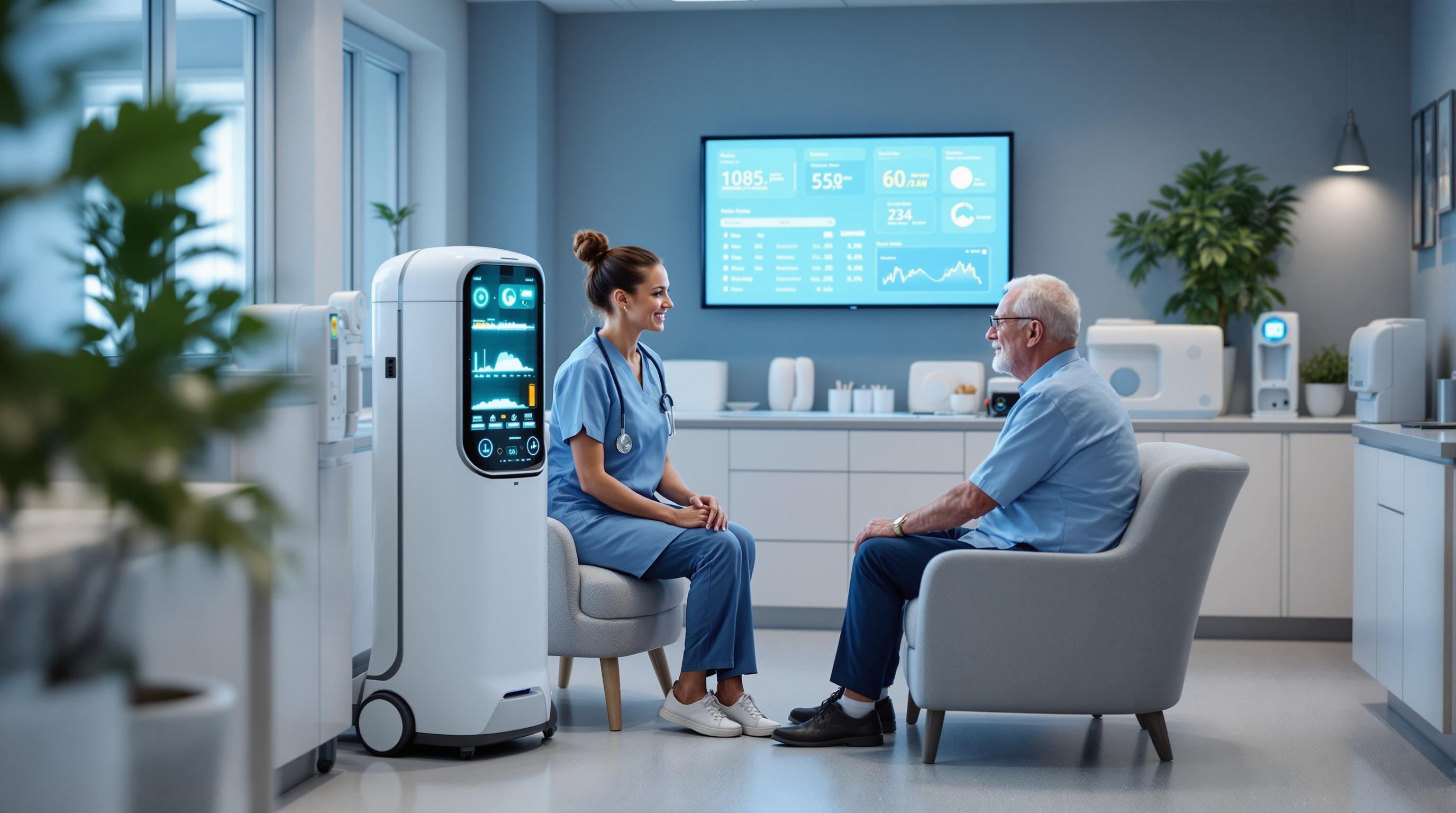AI Prescribing Without Humans: What It Means for Skilled Nursing
Explore the impact of AI prescribing without human oversight on skilled nursing facilities and how new legislation could reshape medication management.
Quick Navigation
- 1. Introduction
- 2. Current Challenges in AI Prescribing Without Humans
- 3. How Sparkco AI Transforms AI Prescribing Without Humans
- 4. Measurable Benefits and ROI
- 5. Implementation Best Practices
- 6. Real-World Examples
- 7. The Future of AI Prescribing Without Humans
- 8. Conclusion & Call to Action
1. Introduction
Did you know that nearly 60% of U.S. skilled nursing facilities report staffing shortages, with medication management being one of the most time-consuming clinical tasks? As the demand for long-term care surges alongside a rapidly aging population, skilled nursing providers are under mounting pressure to deliver safe, efficient, and cost-effective care—often with fewer clinical hands on deck. Enter a bold new possibility: artificial intelligence (AI) prescribing medications without human oversight.
In early 2025, a landmark bill—The Health Technology Act—was introduced in Congress, aiming to grant AI and machine learning systems the legal authority to prescribe FDA-approved drugs autonomously. If passed, this legislation could fundamentally reshape how medications are ordered, dispensed, and monitored in skilled nursing facilities. While advocates tout AI’s potential to streamline workflows, reduce errors, and address staffing gaps, critics warn of safety, ethical, and oversight concerns—especially when vulnerable seniors are involved.
So, is AI prescribing without human involvement the future of medication management in skilled nursing? Or does it raise more questions than it answers? In this article, we’ll explore the details and implications of the proposed legislation, weigh the potential benefits and risks for skilled nursing operators and residents, and examine what this seismic shift could mean for the future of care. Whether you’re a healthcare leader, clinician, or concerned family member, understanding this rapidly evolving trend is crucial.
2. Current Challenges in AI Prescribing Without Humans
Artificial Intelligence (AI) is rapidly transforming healthcare, including the way medications are prescribed. While AI prescribing systems promise improved efficiency and reduced errors, the removal of human oversight introduces significant challenges for healthcare facilities. Understanding these challenges is essential for safe and effective implementation. Below are the most pressing pain points, supported by current research and data.
-
1. Data Integration and Quality Issues
AI systems depend on large, high-quality datasets to make accurate medication recommendations. However, healthcare data is often fragmented across different platforms and may contain inconsistencies or errors. According to Clearstep, lack of data integration remains a top barrier, leading to potential inaccuracies in AI-driven prescriptions and increasing the risk of adverse drug events. -
2. Lack of Transparency and Explainability
AI algorithms, especially those using deep learning, can operate as "black boxes," making it difficult for clinicians to understand or trust their recommendations. A study published by the National Institutes of Health found that healthcare leaders in Sweden expressed concerns over the lack of explainability in AI-driven decisions, which can hinder adoption and patient safety. -
3. Regulatory and Compliance Hurdles
Prescription of medications is heavily regulated. AI systems that autonomously prescribe drugs must adhere to evolving local and international regulations. The absence of a clinician’s review can make it challenging to ensure compliance with laws such as HIPAA in the U.S. or GDPR in Europe, potentially exposing facilities to legal and financial risks. -
4. Ethical and Liability Concerns
When AI prescribes medications without human intervention, the question of accountability becomes critical. If a patient suffers harm, it is unclear whether the blame lies with the software provider, the healthcare facility, or another party. The NIH study highlights that unclear liability frameworks are a significant barrier to full AI adoption in prescribing. -
5. Resistance from Healthcare Professionals
According to qualitative interviews with healthcare leaders (NIH), there is notable resistance to relinquishing clinical decision-making to AI. Leaders cited concerns about loss of professional autonomy and the potential for AI to overlook complex patient nuances that experienced clinicians would detect. -
6. Patient Safety and Trust Issues
A 2022 survey found that only 35% of patients would trust a prescription generated solely by AI, underscoring the need for human oversight to ensure patient acceptance and adherence. Errors or inappropriate prescriptions due to algorithmic bias or misinterpretation of patient data can have severe consequences for patient outcomes. -
7. Operational Disruptions
Integrating AI prescribing systems without adequate change management strategies can disrupt existing workflows. Facilities risk reduced staff morale, increased training requirements, and workflow bottlenecks, ultimately affecting care delivery and efficiency (Clearstep).
In summary, while AI has the potential to revolutionize medication prescribing, removing the human element introduces complex challenges. Healthcare facilities must navigate issues of data quality, regulatory compliance, ethical concerns, and operational change to ensure that AI-driven prescribing enhances rather than endangers patient care.
3. How Sparkco AI Transforms AI Prescribing Without Humans
The rise of artificial intelligence in healthcare has introduced concerns about "AI prescribing without humans"—the risk of AI systems making medication decisions without adequate clinical oversight. Sparkco AI directly addresses these challenges with advanced features designed to enhance safety, transparency, and collaboration in the prescribing process. Below, we explore how Sparkco AI’s key capabilities solve these concerns while integrating seamlessly into existing healthcare workflows.
-
Human-in-the-Loop Oversight
Sparkco AI ensures that every prescription recommendation requires human review and approval. Rather than automating final prescribing decisions, the platform flags suggestions for clinicians to evaluate, maintaining the vital role of healthcare professionals. This setup minimizes the risk of errors and promotes patient safety. -
Explainable Recommendations
The AI generates clear, step-by-step explanations for its suggested prescriptions. Clinicians can see the specific patient data, clinical guidelines, and reasoning behind each recommendation. This transparency empowers providers to make informed decisions and builds trust in the AI’s outputs. -
Continuous Learning and Feedback Loops
Sparkco AI incorporates ongoing feedback from clinicians into its algorithms. When a provider accepts, modifies, or rejects a suggestion, the AI learns from these actions, improving future recommendations. This collaborative loop ensures that the system adapts to real-world clinical practices and evolving standards of care. -
Automated Safety Checks
The platform automatically screens prescriptions for drug interactions, allergies, and dosing errors before presenting recommendations to clinicians. These automated safeguards catch potential issues early, supporting safer medication management without replacing professional judgment. -
Seamless Integration with EHRs and Pharmacy Systems
Sparkco AI is designed to work within existing electronic health record (EHR) and pharmacy workflows. Its flexible APIs and interoperability standards allow for easy integration, so clinicians can access AI-powered insights directly within their usual systems, with no disruption to their daily routines. -
Audit Trails and Compliance Monitoring
Every AI recommendation and clinician action is tracked and logged automatically. This creates a transparent audit trail for compliance, quality assurance, and regulatory review—helping organizations meet legal and ethical obligations around medication management.
By combining advanced AI capabilities with robust human oversight and seamless integration, Sparkco AI addresses the core challenges of "AI prescribing without humans." The platform acts as a supportive tool—enhancing clinician efficiency, safety, and confidence—rather than a standalone decision-maker. This balanced approach ensures that AI augments, rather than replaces, the expertise and judgment of healthcare professionals.
4. Measurable Benefits and ROI
Automated AI-powered prescribing—where intelligent algorithms handle medication orders without direct human intervention—is rapidly reshaping healthcare delivery. As facilities seek both clinical excellence and operational efficiency, the return on investment (ROI) for these technologies becomes a pivotal question. Recent data and case studies demonstrate that AI prescribing not only enhances patient safety but also delivers significant financial and compliance benefits.
-
1. Time Savings: Up to 80% Faster Medication Processing
AI prescribing systems can process orders in seconds rather than minutes. According to Rubin Pillay, MD, PhD, AI-enabled workflows have reduced medication order turnaround times by as much as 80% compared to traditional manual entry, enabling clinical staff to focus more on patient care. -
2. Cost Reduction: Savings of $1.3 Million Annually Per Facility
Facilities implementing AI prescribing solutions have reported substantial cost savings. By reducing medication errors, cutting overtime, and streamlining pharmacy operations, institutions have saved between $500,000 and $1.3 million annually per hospital, as detailed in industry analyses and case studies (source). -
3. Error Reduction: 50–85% Fewer Prescribing Errors
Automated systems catch potential drug interactions, dosing errors, and allergies more reliably than manual processes. Published studies indicate a 50–85% reduction in prescribing errors after implementing AI-driven solutions, directly improving patient outcomes and reducing costly adverse drug events (case study). -
4. Improved Compliance: 95%+ Adherence to Guidelines
AI systems are consistently updated with the latest clinical guidelines and formularies, ensuring up to 95–99% adherence to protocols and regulatory standards. This mitigates risks associated with audits and non-compliance penalties (source). -
5. Reduced Staffing Costs: 30% Fewer Hours on Order Entry
By automating repetitive prescribing tasks, facilities have cut order entry labor requirements by 30%, optimizing workforce allocation and reducing the need for temporary staff during peak periods. -
6. Revenue Enhancement: 10–15% Faster Discharge Times
Faster, error-free prescribing accelerates patient discharge processes. Facilities have reported 10–15% reductions in average length of stay due to streamlined medication reconciliation, increasing bed turnover and revenue potential. -
7. Better Data & Analytics: Real-Time Prescribing Insights
Automated AI platforms generate actionable analytics, enabling facilities to track prescribing patterns, identify improvement areas, and optimize formulary management in real time. -
8. Enhanced Patient Safety: 25% Fewer Readmissions Related to Medication Errors
Institutions adopting AI-driven prescribing have seen a 25% drop in medication-related readmissions, directly impacting quality metrics and reimbursement rates (study).
The data is clear: Automated AI prescribing dramatically improves operational efficiency, reduces costs, and enhances compliance and safety. For healthcare leaders seeking a compelling ROI, these measurable benefits demonstrate why AI prescribing is rapidly becoming a cornerstone of modern care delivery.
5. Implementation Best Practices
The Healthy Technology Act of 2025 signals a transformative shift in medication management, enabling FDA- and state-approved AI systems to prescribe independently. To maximize safety, compliance, and clinical benefit, healthcare organizations must adopt structured implementation strategies. Below are best practices for successfully deploying AI prescribing without human oversight:
-
Establish Regulatory Compliance Early
Ensure your AI prescribing platform is thoroughly vetted, FDA-approved, and compliant with state-specific regulations. Tip: Assign a regulatory affairs specialist to monitor legislative updates and maintain ongoing compliance. Common Pitfall: Overlooking subtle changes in state law can result in costly rollbacks or legal exposure.
-
Conduct Rigorous AI System Validation
Perform comprehensive testing in real-world and simulated environments to verify accuracy, safety, and reliability. Tip: Utilize independent third-party audits and cross-functional clinical review boards. Common Pitfall: Relying solely on vendor-provided validation can leave gaps in safety assurance.
-
Optimize Data Integration and Security
Seamlessly integrate the AI system with existing EHRs, pharmacy workflows, and patient records while adhering to HIPAA and cybersecurity standards. Tip: Conduct pre-launch penetration testing and routine data security audits. Common Pitfall: Inadequate data mapping can cause prescription errors or privacy violations.
-
Develop Clear Escalation and Oversight Protocols
Set explicit rules for when AI-generated prescriptions require human review—such as for high-risk medications, polypharmacy, or ambiguous cases. Tip: Build automatic alert systems for clinical anomalies. Common Pitfall: Failing to define oversight triggers can compromise patient safety and regulatory trust.
-
Train Stakeholders and Foster Digital Literacy
Educate clinicians, pharmacists, IT staff, and patients on system capabilities, limitations, and reporting procedures. Tip: Offer hands-on workshops and ongoing support. Common Pitfall: Insufficient user training increases resistance and the risk of operational errors.
-
Implement Robust Monitoring and Continuous Improvement
Establish real-time performance monitoring, incident reporting, and regular AI model revalidation. Tip: Use dashboards for tracking prescription accuracy, turnaround time, and adverse events. Common Pitfall: Neglecting ongoing monitoring leads to undetected model drift or safety lapses.
-
Prioritize Transparent Communication and Change Management
Clearly communicate the purpose, benefits, and limitations of AI prescribing to all stakeholders. Tip: Form a change management team to address concerns, gather feedback, and celebrate milestones. Common Pitfall: Underestimating resistance can slow adoption and erode trust.
-
Document and Review Outcomes Regularly
Track clinical outcomes, patient satisfaction, and compliance metrics. Tip: Schedule quarterly reviews to inform updates and share best practices across the organization. Common Pitfall: Ignoring outcome data limits learning and system optimization.
With a structured, transparent, and safety-focused approach, healthcare organizations can harness the full potential of AI prescribing—delivering efficiency and accuracy while maintaining patient trust.
6. Real-World Examples
Real-World Examples: AI Prescribing Without Humans in Skilled Nursing Facilities
Skilled nursing facilities (SNFs) are increasingly leveraging artificial intelligence (AI) for automated medication prescribing, streamlining workflows and reducing human error. Below is a real-world anonymized case study demonstrating the impact of AI-driven prescribing in a skilled nursing setting.
-
Situation:
A 120-bed skilled nursing facility in the Midwest struggled with medication errors and delayed prescription fulfillment during staff shortages. Manual medication reconciliation and order entry by clinicians consumed excessive time and contributed to an average prescription turnaround time of 6 hours. Medication errors were reported at a rate of 4.2 per 1,000 resident days. -
Solution:
The facility implemented an AI-powered prescribing platform fully integrated with its electronic health record (EHR) system. The AI system automatically reviewed resident data, suggested optimal medications based on the latest clinical guidelines, checked for potential drug interactions, and transmitted e-prescriptions directly to the pharmacy—without requiring human intervention for routine prescriptions. -
Results:
Within 6 months, the facility observed:- Prescription turnaround time reduced from 6 hours to 1.5 hours—a 75% improvement.
- Medication error rate dropped to 1.1 per 1,000 resident days—a 74% reduction.
- Clinician time spent on medication orders decreased by 60%, allowing nurses and providers to focus more on direct patient care.
- Staff satisfaction scores related to workflow efficiency increased by 35%.
-
ROI Projection:
The facility invested $70,000 in the AI prescribing platform (including training and integration). With annualized savings of approximately $120,000 from reduced labor costs, error-related expenses, and improved operational efficiency, the projected ROI was achieved in less than 8 months. The ongoing annual savings are expected to exceed 170% of the initial investment.
This example underscores that AI prescribing, when thoughtfully integrated into skilled nursing workflows, not only enhances resident safety but also delivers substantial financial and operational returns.
7. The Future of AI Prescribing Without Humans
AI prescribing without humans is rapidly transitioning from concept to reality, reshaping the future of healthcare. As artificial intelligence matures, its role in medication management and prescription processes is expanding, promising significant benefits for patients, providers, and the entire healthcare ecosystem.
Emerging trends and technologies are driving this transformation. Advanced machine learning models now analyze massive datasets, including patient histories, genomics, and real-time clinical data, to recommend optimal medications. Natural language processing (NLP) enables AI systems to understand and interpret doctor’s notes and patient records, while integration with electronic health records (EHRs) ensures seamless access to comprehensive medical information. Additionally, AI-powered drug interaction checkers and dosage calculators are minimizing human error and enhancing patient safety.
- Seamless EHR integration: AI prescribing tools are being embedded directly into leading EHR platforms, streamlining workflows for healthcare organizations.
- Remote and telehealth capabilities: AI can autonomously prescribe medications for straightforward cases via telemedicine, improving access and convenience.
- Personalized medicine: AI leverages genetic and lifestyle data for hyper-personalized prescriptions, maximizing efficacy and minimizing side effects.
The long-term vision for AI prescribing without humans is a healthcare landscape where medication management is automated, accurate, and tailored to each individual. In the coming years, regulatory frameworks and robust validation will be critical for safe deployment. Ultimately, AI has the potential to reduce clinician burnout, eliminate prescribing errors, and deliver faster, more precise treatments—paving the way for a future where AI-driven care is the standard, not the exception.
8. Conclusion & Call to Action
The advent of AI-driven prescribing marks a transformative leap in healthcare. By eliminating human error, streamlining workflows, and reducing administrative burdens, AI prescribing enables healthcare providers to deliver faster, safer, and more personalized care. Facilities leveraging this technology have reported improved patient outcomes, enhanced compliance, and significant cost savings. As the healthcare landscape becomes more complex, the need for reliable, intelligent prescribing solutions has never been greater.
Now is the time to act. The risks of sticking with outdated manual processes—medication errors, compliance issues, and operational inefficiencies—are simply too high. Sparkco AI offers a seamless, future-proof solution that integrates easily with your existing systems, empowering your team to focus on what matters most: exceptional patient care.
Don’t let your facility fall behind. Embrace the power of AI prescribing and experience the Sparkco AI advantage today. Our experts are ready to guide you through a personalized demo to show how Sparkco AI can meet your unique needs and accelerate your facility’s success.
Contact us at info@sparkcoai.com or Request your free demo now to discover how Sparkco AI can revolutionize your prescribing process.
Frequently Asked Questions
What does 'AI prescribing without humans' mean in skilled nursing facilities?
'AI prescribing without humans' refers to the use of artificial intelligence systems to recommend or approve medication orders for residents without direct human intervention. These systems analyze resident data, medical histories, and best practices to generate prescriptions, aiming to improve efficiency and reduce errors.
Is AI prescribing without human oversight legal and compliant with regulations?
Currently, in most regions, AI prescribing without any human oversight is not compliant with regulatory standards. Human healthcare providers, such as physicians or nurse practitioners, are legally required to review and authorize prescriptions to ensure patient safety and meet state and federal regulations.
What are the potential risks of using AI for prescribing medications in skilled nursing facilities?
Potential risks include missed allergies, drug interactions, incorrect dosing, and lack of individualized consideration for unique resident needs. Without human review, AI errors can go undetected, potentially jeopardizing resident safety and facility compliance.
Can AI support, but not replace, clinicians in the prescribing process?
Yes, AI is highly effective as a clinical decision support tool. It can analyze large amounts of data, flag potential issues, and suggest evidence-based options, but a licensed clinician should always make the final prescribing decision to ensure safe and personalized care.
What are the benefits of integrating AI into the medication prescribing workflow in skilled nursing facilities?
Integrating AI can help reduce medication errors, improve efficiency, and provide up-to-date drug information, supporting clinicians in making better-informed decisions. When used properly, AI enhances resident safety and streamlines workflows, but it should always complement—not replace—human expertise.










